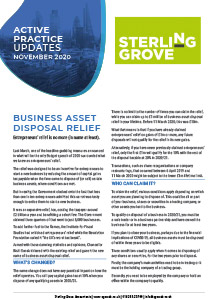Resource Hub
Business Asset Disposal Relief
Entrepreneurs’ relief is no more (in name at least).
Last March, one of the headline-grabbing measures announced in what will be the only Budget speech of 2020 surrounded what we knew as entrepreneurs’ relief.
The relief was designed to be an incentive for entrepreneurs to start a new business by reducing the amount of capital gains tax payable when the time came to dispose of (or sell) certain business assets, where conditions are met.
But in reality, the Government clocked onto the fact that less than one in ten entrepreneurs admitted this carrot was tasty enough to entice them to start a new business.
It was an expensive relief, too, costing the taxpayer around £2 billion a year and benefitting a select few. The Government claimed three quarters of that went to just 5,000 businesses.
To add further fuel to the flames, the Institute for Fiscal Studies had criticised entrepreneurs’ relief while the Resolution Foundation called it “the UK’s worst tax break”.
Armed with those damning statistics and opinions, Chancellor Rishi Sunak tinkered with the existing relief and gave it the new name of business asset disposal relief.
WHAT’S CHANGED?
The name change does not have any practical impact on how the relief operates. You still pay capital gains tax at 10% when you dispose of any qualifying assets in 2020/21.
There is no limit to the number of times you can claim the relief, while you can claim up to £1 million of business asset disposal relief in your lifetime. Before 11 March 2020, this was £10m.
What that means is that if you have already claimed entrepreneurs’ relief on gains of £1m or more, any future disposals will not qualify for the relief in its new guise.
Alternatively, if you have never previously claimed entrepreneurs’ relief, only the first £1m will qualify for the 10% with the rest of the disposal taxable at 20% in 2020/21.
Transactions, such as share reorganisations or company restructurings, that occurred between 6 April 2019 and 11 March 2020 might be subject to the lower £1m lifetime limit.
WHO CAN CLAIM IT?
To claim the relief, various conditions apply depending on which asset you are planning to dispose of. This could be all or part of your business, shares or securities in a trading company, or other assets you lent to the business.
To qualify on disposal of a business in 2020/21, you must be a sole trader or in a business partnership and have owned the business for at least two years.
If you plan to close your business, perhaps due to the financial implications of COVID-19, all business assets must be disposed of within three years to be eligible.
Three conditions usually apply when it comes to disposing of any shares or securities, for the two years prior to disposal.
Firstly, the company’s main activities need to be in trading or it must be the holding company of a trading group.
Secondly, you need to be employed by the company or hold an office within the company to qualify.
You must also hold 5% of both the shares and voting rights, and be entitled to at least 5% of either the profits available for distribution plus the assets on winding up the company or the disposal proceeds if the company is sold.
Other eligibility rules kick in if the shares are from an enterprise management initiative, although the 5% condition will not apply.
If the company stops trading, you have to sell the shares within three years to be eligible for the relief.
When it comes to selling assets you lent to the business, you must sell at least 5% of your part of a business partnership or your shares in a personal company.
You should also have owned assets your business partnership or company used for at least a year prior to the date they were sold or the date the business closed.
THE CALCULATION
Whether you qualify for entrepreneurs’ relief or the new business asset disposal relief, the calculation is the same.
Remember, this is not a capital gains tax exemption. It simply allows you to reduce the rate of capital gains tax you pay on any profits made on disposal of eligible business assets.
Gains from one asset
Where the only profit you make in a tax year arises from the disposal of any business asset or your business itself, and qualifies for this relief, only one capital gains tax rate applies.
We approach this by establishing the overall profit made, deducting any qualifying costs and subtracting those from your gain. We then take off your capital gains tax allowance, which is
£12,300 in 2020/21, to further lower your tax bill.
Once this allowance has been applied, your capital gains tax bill will be 10% of that final figure.
Gains from several assets
If you have additional gains from the disposal of other chargeable assets which don’t qualify for entrepreneurs’ relief, your usual capital gains tax rates will apply. How much tax you owe depends on your marginal rate of income tax.
For higher-rate or additional-rate taxpayers, tax is charged at 28% on any gains made on residential properties that are not your main residence. A rate of 20% applies to the disposal of other types of chargeable assets.
CLAIMING THE RELIEF
Just like entrepreneurs’ relief, you can claim business asset disposal relief in your tax return if the sale of your business or any qualifying business asset goes through in 2020/21.
If you are filing a tax return for the sole purpose of claiming this relief, you have a deadline of the first anniversary of 31 January following the end of the tax year in which you made the disposal.
For disposals in 2020/21, that’s on 31 January 2023.
Alternatively for any disposals of qualifying assets in 2020/21, you can complete a business asset disposal relief helpsheet which is available on the GOV.UK website. We can easily take this off your hands, too.
Disposals before 2020/21
For qualifying business assets sold after 11 March 2020, the new £1m lifetime limit applies. Other qualifying assets sold before this point might be eligible for the old £10m lifetime limit.
If your business was sold before 11 March 2020, you have a deadline of the first anniversary of 31 January following the end of the tax year in which you made the disposal. For example, if you sold or closed your business in the 2018/19 tax year, you have until 31 January 2021 to claim the relief. Any profits arising from the disposal of qualifying business assets in 2019/20 have to be claimed before 31 January 2022 – and so on
Contact us today to discuss how we can help you put together a road map that will keep your business on course for growth and success.

